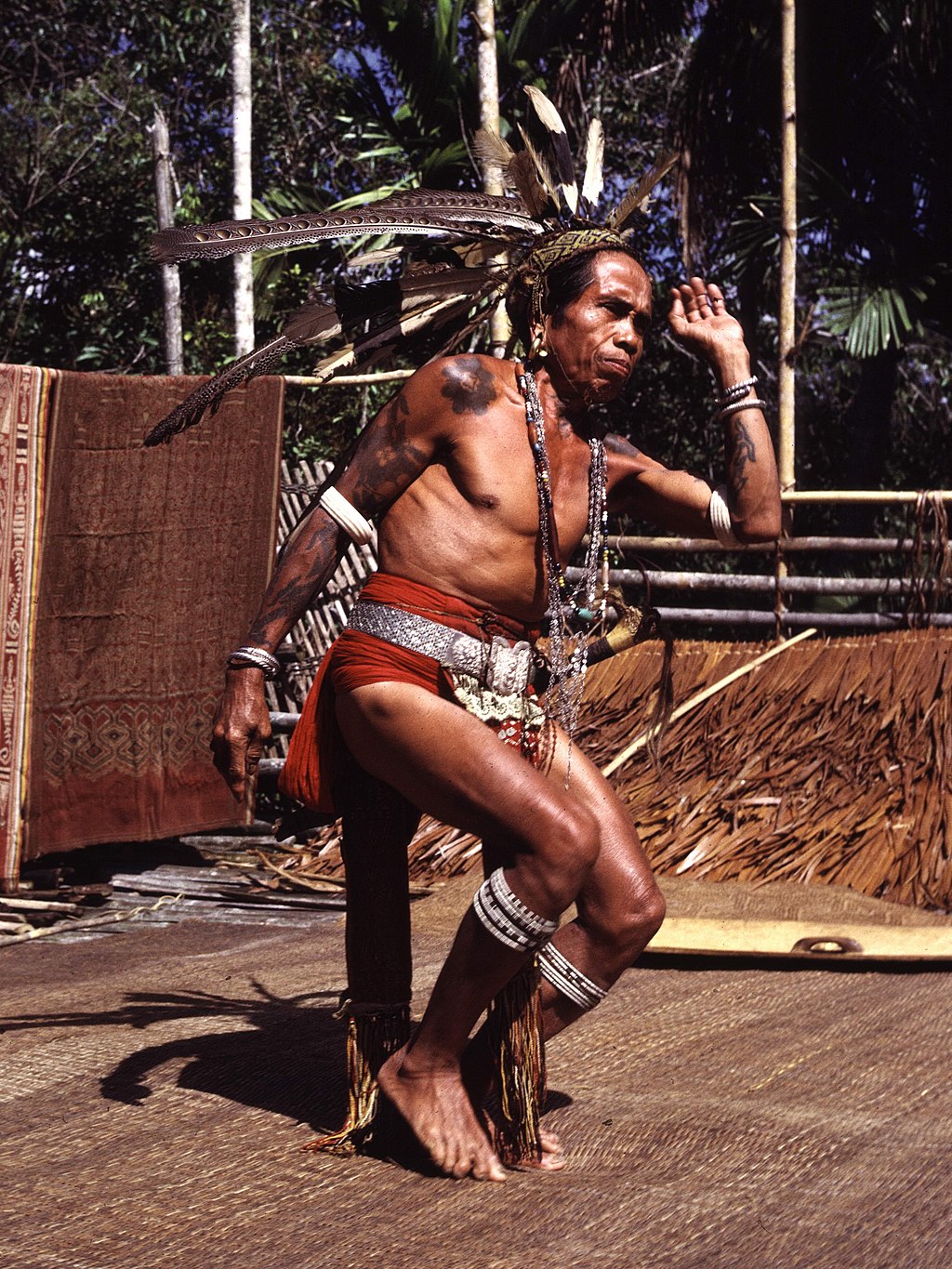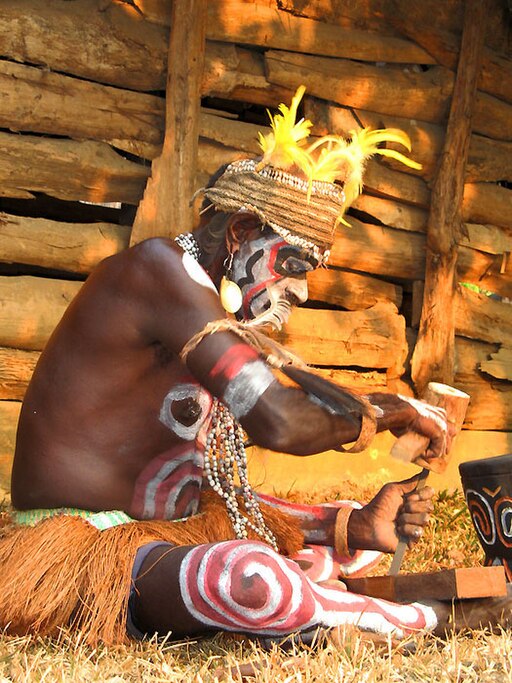Indigenous Peoples in Indonesia
Indonesia is home to many indigenous peoples, each with their own unique cultures and histories. Here are some of the main indigenous peoples in Indonesia and ethnic groups and where they live:
Dayak people
The Dayak are indigenous peoples of Borneo, living mainly in Kalimantan, the Indonesian part of Borneo. They have their own language and culture, and traditionally relied on agriculture and forestry for their livelihood. There are various sub-ethnic groups of Dayak, including the Iban, Kenyah, Kayan, and Punan.

Dayak people in Borneo. ASITRAC, CC BY-SA 4.0, via Wikimedia Commons
Mentawai people
The Mentawai are indigenous peoples of the Mentawai Islands, off the coast of Sumatra. They have their own language and culture, and traditionally relied on hunting, fishing, and slash-and-burn agriculture for their livelihood. They are known for their intricate tattoos and unique way of life.
Minangkabau people
The Minangkabau are an indigenous people of West Sumatra, known for their matrilineal society and unique architecture. They have their own language and culture, and traditionally relied on agriculture and trade for their livelihood.
Papuan people
The Papuan people are indigenous peoples of Papua, the easternmost province of Indonesia. They have their own languages and cultures, and traditionally relied on hunting, fishing, and subsistence agriculture for their livelihood.
Sasak people
The Sasak are indigenous peoples of Lombok, an island east of Bali, located in West Nusa Tenggara province. They have their own language and culture, and traditionally relied on agriculture and fishing for their livelihood.
Toraja people
The Toraja are indigenous peoples of Sulawesi, living mainly in the Tana Toraja region. They have their own language and culture, and traditionally relied on agriculture and livestock herding for their livelihood.
Batak people
The Batak are indigenous peoples of North Sumatra, living mainly in the Toba Lake region, Karo, and Simalungun regions. They have their own language and culture, and traditionally relied on agriculture, fishing, and hunting for their livelihood. and trade for their livelihood.
Toba people
The Toba are indigenous peoples of North Sumatra, living mainly in the Toba region around Lake Toba. They have their own language and culture, and traditionally relied on agriculture and fishing for their livelihood. They are known for their traditional houses and music.
Acehnese people
The Acehnese are indigenous peoples of Aceh, a province in the northern tip of Sumatra. They have their own language and culture, and traditionally relied on agriculture, fishing, and trade for their livelihood. They are known for their strong Islamic faith and unique customs.
Dani people
The Dani are indigenous peoples of Papua, living mainly in the Baliem Valley. They have their own language and culture, and traditionally relied on hunting, fishing, and subsistence agriculture for their livelihood.

Dani people from the central highlands of western New Guinea. Udomunich, CC BY-SA 4.0, via Wikimedia Commons
These are just a few of the many indigenous peoples in Indonesia. It’s important to recognize and celebrate their diversity and work towards preserving their cultures and protecting their rights.
Asmat people
The Asmat are indigenous peoples of Papua, living in the coastal and swampy regions of southern Papua. They have their own language and culture, and are known for their intricate woodcarvings and traditional art.

Asmat people from Papua. Edi Wibowo, CC BY-SA 3.0, via Wikimedia Commons
Baduy people (Sundanese ethnic group)
The Baduy are indigenous peoples of Banten province, on the island of Java. They have their own language and culture, and live in isolated communities that maintain strict traditional customs and beliefs.
Bajau people
The Bajau are indigenous peoples of the coastal regions of Indonesia, Malaysia, and the Philippines. They are known for their seafaring skills and traditionally lived in houseboats or stilt houses near the sea.
Balinese people
The Balinese are indigenous peoples of Bali, an island in Indonesia. They have their own language and culture, and are known for their traditional dance, music, and arts.
Read also: Travel to Bali: the guide to read before your departure

Bratan, Bali, Indonesia: Balinese family after the Hindu worship service (“puja”) in Pura Ulun Danu Bratan. The wet rice grains on the foreheads are called “Bija”, meaning “God has blessed us”.
Photo by CEphoto, Uwe Aranas (CC BY-SA 3.0) via Wikimedia Commons
Dayak Ngaju people
The Dayak Ngaju are indigenous peoples of Central Kalimantan, in Borneo. They have their own language and culture, and traditionally relied on agriculture and forestry for their livelihood.
Kubu people
The Kubu are indigenous peoples of Sumatra, living mainly in the Jambi and Riau provinces. They have their own language and culture, and traditionally relied on hunting, gathering, and slash-and-burn agriculture for their livelihood.
Sumbanese people
The Sumbanese are indigenous peoples of Sumba, an island in eastern Indonesia. Sumba people have their own language and culture, and traditionally relied on agriculture and weaving for their livelihood. They are known for their unique megalithic culture and the famous Pasola festival.
Tanimbarese people
The Tanimbarese are indigenous peoples of the Tanimbar Islands, located in eastern Indonesia. They have their own language and culture, and traditionally relied on agriculture and fishing for their livelihood.
Wemale people
The Wemale are indigenous peoples of Seram Island, in eastern Indonesia. They have their own language and culture, and traditionally relied on agriculture, fishing, and hunting for their livelihood.
These are just a few more examples of the many indigenous peoples in Indonesia, each with their own unique culture and way of life.
Some more indigenous groups in Indonesia:
Nias people
The Nias people are indigenous peoples of Nias Island, located off the western coast of Sumatra. They have their own language and culture, and traditionally relied on agriculture, fishing, and weaving for their livelihood.
Benuaq people
The Benuaq are indigenous peoples of East Kalimantan, in Borneo. They have their own language and culture, and traditionally relied on agriculture, hunting, and fishing for their livelihood.
Bugis people
The Bugis are indigenous peoples of Sulawesi, living mainly in the southern part of the island. They have their own language and culture, and traditionally relied on maritime trade and agriculture for their livelihood.
Orang Rimba people or Suku Anak Dalam people
The Orang Rimba are indigenous peoples of Sumatra, living mainly in Jambi and South Sumatra provinces. They have their own language and culture, and traditionally relied on hunting, gathering, and shifting cultivation for their livelihood.
The Suku Anak Dalam, also known as Orang Kubu, are indigenous peoples of Jambi and Riau provinces in Sumatra. They have their own language and culture, and traditionally relied on hunting, gathering, and shifting cultivation for their livelihood.

The Suku Abak Dalam are the original inhabitants of Bukit Duabelas National Park. The Kubu tribe, also known as the Anak Dalam tribe or Orang Rimba, is a minority ethnic group that lives on the island of Sumatra, to be precise in the provinces of Jambi and South Sumatra. The community living in the forest in Jambi Province calls themselves Orang Rimba. Abusalwasalmanshakila, CC BY-SA 4.0, via Wikimedia Commons
Kubu Raya people
The Kubu Raya are indigenous peoples of West Kalimantan, in Borneo. They have their own language and culture, and traditionally relied on agriculture and hunting for their livelihood.
Lampung people
The Lampung are indigenous peoples of Lampung province, located in the southern part of Sumatra. They have their own language and culture, and traditionally relied on agriculture and fishing for their livelihood.
Mandailing people
The Mandailing are indigenous peoples of North Sumatra, living mainly in the Tapanuli region. They have their own language and culture, and traditionally relied on agriculture, hunting, and fishing for their livelihood.
Urak Lawoi people
The Urak Lawoi are indigenous peoples of the islands around Phuket, Thailand, but also living in parts of Indonesia. They are known for their seafaring skills and traditionally lived in houseboats or stilt houses near the sea.
These are just a few more examples of the many indigenous peoples in Indonesia, each with their own unique culture and way of life.
Here are some more indigenous people in Indonesia:
Javanese people
The Javanese are indigenous peoples of Java, the most populous island in Indonesia. They have their own language and culture, and are known for their traditional dance, music, and arts.
Kaili people:The Kaili are indigenous peoples of Central Sulawesi. They have their own language and culture, and traditionally relied on agriculture and fishing for their livelihood.
Nagekeo people
The Nagekeo are indigenous peoples of Nagekeo Regency, located in East Nusa Tenggara province. They have their own language and culture, and traditionally relied on agriculture, fishing, and weaving for their livelihood.
Rejang people
The Rejang are indigenous peoples of Bengkulu province, located in southwestern Sumatra. They have their own language and culture, and traditionally relied on agriculture and fishing for their livelihood.
Tenggerese people
The Tenggerese are indigenous peoples of the Tengger mountains in East Java. They have their own language and culture, and are known for their unique customs and beliefs, including the annual Kasada ceremony.
Tolaki people
The Tolaki are indigenous peoples of Southeast Sulawesi. They have their own language and culture, and traditionally relied on agriculture and fishing for their livelihood.
These are just a few more examples of the many indigenous peoples in Indonesia, each with their own unique culture and way of life.
Here are some more indigenous groups in Indonesia:
Sangir people
The Sangir are indigenous peoples of the Sangihe Islands, located off the northern coast of Sulawesi. They have their own language and culture, and traditionally relied on agriculture and fishing for their livelihood.
Wana people
The Wana are indigenous peoples of Central Sulawesi. They have their own language and culture, and traditionally relied on hunting, gathering, and shifting cultivation for their livelihood. They are known for their unique social structure and animist beliefs.
These are just a few more examples of the many indigenous peoples in Indonesia, each with their own unique culture and way of life.
Here’s another list of indigenous Chinese peoples in Indonesia with some explanation and where they are mostly located:
Hokkien: Hokkien people are originally from the Fujian province in China. They are one of the largest and oldest Chinese communities in Indonesia. Most Hokkien people in Indonesia live in major cities such as Jakarta, Surabaya, and Medan.
Teochew
Teochew people are also from the Guangdong province in China. They are known for their distinct accent and culture. Teochew people in Indonesia are mainly found in the Bangka-Belitung Islands, as well as in Medan and Jakarta.
Hakka
The Hakka people are originally from the eastern and northern parts of Guangdong province. They are known for their unique architecture, cuisine, and martial arts. In Indonesia, the Hakka people are mainly found in cities like Jakarta and Surabaya.
Cantonese
Cantonese people are from the Guangdong province in China. They are known for their love of food and vibrant culture. Cantonese people in Indonesia are mainly found in major cities such as Jakarta, Surabaya, and Medan.
Hainanese
The Hainanese people are from the Hainan province in China. They are known for their cuisine, which is based on seafood and spices. Hainanese people in Indonesia are mainly found in Jakarta and other major cities.
Peranakan
The Peranakan people are descendants of Chinese immigrants who settled in the Malay Archipelago. They have assimilated with the local Malay culture and have developed their own unique culture and language. Peranakan people in Indonesia are mainly found in the cities of Medan and Jakarta.

A photo of Siem Piet Nio, Indonesian Chinese feminist writer who wrote under the pen name Hong Le Hoa, probably from the late 1920s or early 1930s. See page for author, Public domain, via Wikimedia Commons
It’s worth noting that many Chinese Indonesians have mixed ancestry and may identify with multiple ethnic groups. Also, the distribution of these ethnic groups is not limited to the cities mentioned above and may vary across the archipelago.
Sources: PinterPandai, Indigenous Peoples Litrature, Human Rights Watch
List of Native Peoples Around the World | Understanding the Diverse Indigenous
Photo credit (main picture): Gunawan Kartapranata, CC BY-SA 4.0, via Wikimedia Commons
Photo description: A large ethnic map displayed in the ethnology room of the National Museum of Indonesia, Jakarta. The portraits of native Indonesian ethnicities are displayed surrounding the map.


